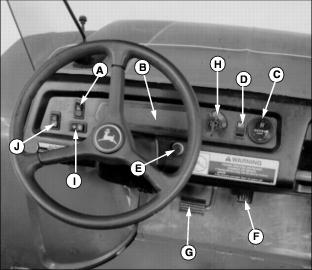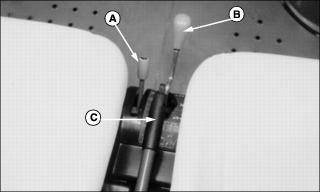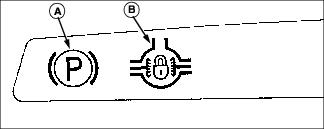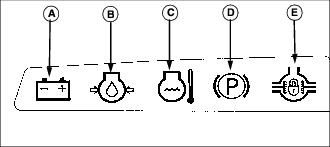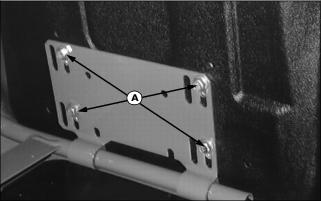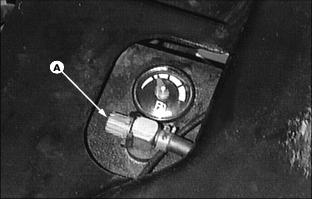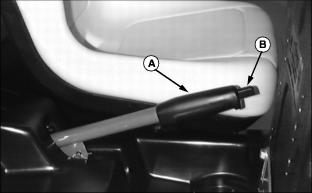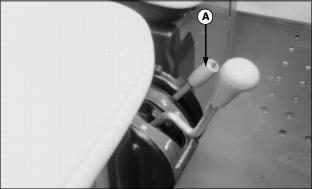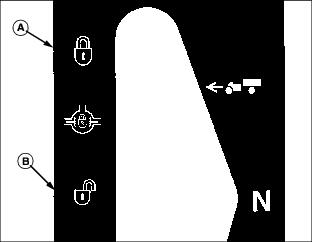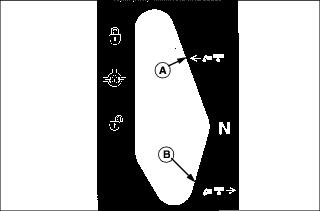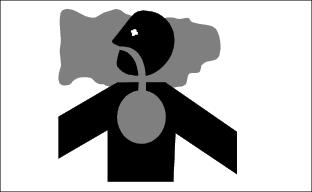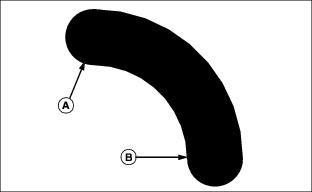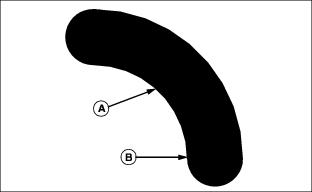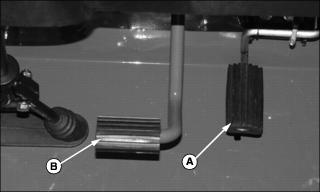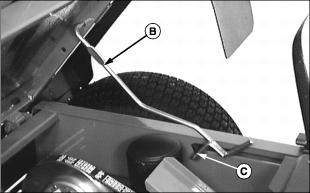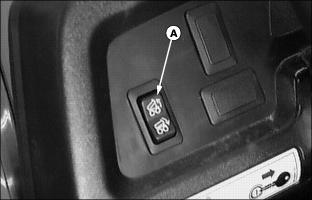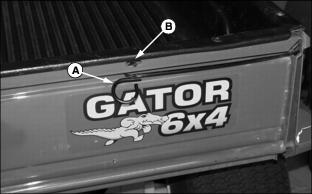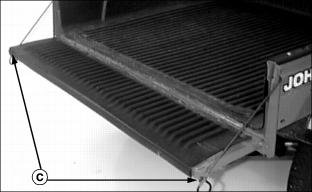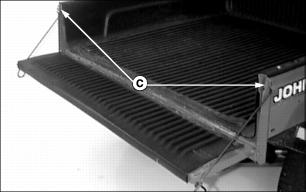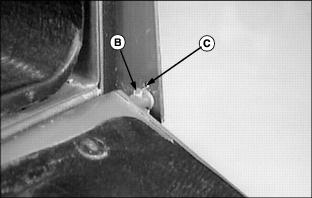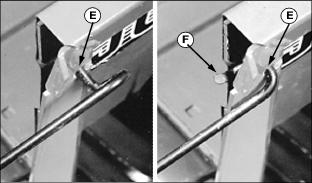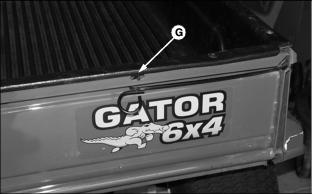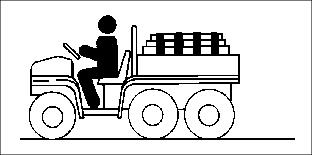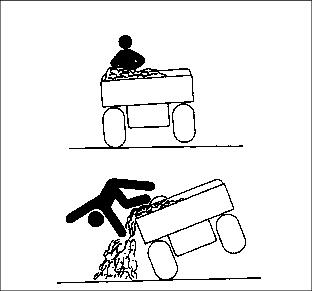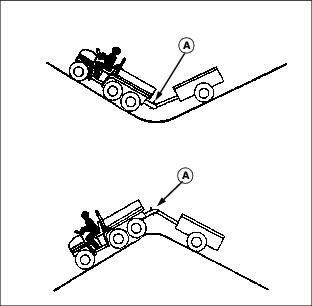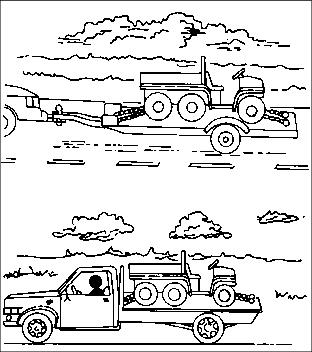Introduction
Product Identification
Safety
Operating
Testing the Safety Start System
Raising and Lowering Cargo Box
Installing Tailgate Latch Rods
Replacement Parts
Service Intervals
Service Lubrication
Service Engine
Service Transmission
Service Electrical
Service Miscellaneous
Troubleshooting
Storage
Assembly
Specifications
Warranty
John Deere Quality Statement
Service Record
Copyright© Deere & Company

Operating
Daily Operating Checklist
o Check coolant level (GATOR 6x4).
o Clean operator's station and engine compartment.
o Clean engine cooling screens (GATOR 4x2).
Operator Controls
A - Warning Light Switch (Optional)
I - Turn Signal Switch and Indicator (Optional)
J - Cargo Box Power Lift Switch (Optional)
Miscellaneous Controls
NOTE: Fuel shut-off valve installed on early model machines only.
Indicator Panel (4x2)
Indicator Panel (6x4)
Using Hand Holds
Hand holds (A) are provided for passenger balance when driving over rough terrain. Use dash bar and side rails on seats for stability.
Adjusting Seats
Picture Note: Operator seat shown.
3. Slide seat forward or rearward to desired position.
4. Tighten seat bracket hardware to 10 N·m (7 lb-ft).
Using Fuel Shut-Off Valve
NOTE: Fuel shut-off valve is installed on early model machines only. Turn valve to OFF (closed) position before transporting or storing the machine.
1. Tip operator's seat forward.
2. Turn knob (A) to shut off or turn on fuel flow. Valve is on when arrow on knob faces upward.
Using Park Brake
NOTE: Pushing down on brake pedal while locking and unlocking park brake decreases effort required to apply park brake lever.
Locking the Park Brake
2. Pull up on lever (A) and latch into position.
Unlocking the Park Brake
4. Release lever down completely.
Operating Differential Lock
Differential lock (A) provides better traction when rear wheels start to slip. Engaging the differential lock will cause all rear wheels to turn together at equal speed.
Engaging the Differential Lock
IMPORTANT: Avoid damage! Transaxle may be damaged if differential lock is engaged incorrectly. Reduce speed before engaging or disengaging differential lock. |
1. Stop or reduce engine speed to 1\3 throttle or less.
2. Push differential lock lever forward to LOCKED position (A):
· Differential lock will remain engaged as long as lever is forward.
· Panel indicator light will come on.
Disengaging the Differential Lock
NOTE: Panel light only indicates when lever is in ON or OFF position. To ensure true disengagement of differential lock, you must equalize torque on both axles.
1. Stop or reduce engine speed to 1\3 throttle or less.
2. Drive the vehicle straight ahead at a constant speed.
3. Pull lever rearward to UNLOCKED position (B). Panel indicator light will go off.
Using Transaxle Shift Lever
2. Allow engine to come to a low idle speed.
· FORWARD (A) - Push shift lever forward.
· REVERSE (B) - Push shift lever to right, then pull rearward.
Testing Safety Systems
Use the following checkout procedure to check for normal operation of machine.
If there is a malfunction during one of these procedures, Do not operate machine. See your John Deere dealer for service.
Perform these tests in a clear open area. Keep bystanders away.
Testing the Safety Start System
1. Sit on the operator's seat.
2. Place key switch in STOP position (A).
4. Move transaxle shift lever to FORWARD position.
5. Move key switch to START position (B). Engine should NOT crank. Turn key switch OFF.
6. Move transaxle shift lever to REVERSE position.
7. Move key switch to START position. Engine should NOT crank. Turn key switch OFF.
Starting the Engine
1. Sit on operator seat. DO NOT start engine at this time.
2. Push down on accelerator pedal to check for free movement of pedal assembly. Release pedal.
NOTE: The vehicle has a neutral start safety switch. The engine will not start unless the transaxle shift lever is in N (Neutral) position.
3. Move gear shift lever to N (Neutral) position.
5. Turn key switch to the RUN position (A).
6. Check that the battery discharge and oil pressure indicator lights are on (GATOR 6x4).
7. Pull out on choke if engine is cold.
8. Turn key to START position (B).
· Coolant temperature indicator light should come, then go off after a few seconds.
IMPORTANT: Avoid damage! Starter may be damaged if starter is operated for more than 20 seconds at a time: · Wait two minutes before trying again if engine does not start. |
9. Release key to the RUN position when engine starts.
· If engine does not start within five seconds, turn key to OFF and wait ten seconds before trying to start again.
· In very cold conditions, attempt starting engine three times only, then wait 5 minutes before trying again. This will allow time for starter to cool and prevent damage to starter.
IMPORTANT: Avoid damage! Do not operate the engine at full throttle or under load until engine has warmed up, or engine damage could occur. |
11. Run engine at half speed for 2 or 3 minutes to warm the engine.
Stopping Engine
Always lock the park brake and remove the key before leaving the machine unattended. |
IMPORTANT: Avoid damage! If engine has been running hard and is hot, do not stop engine immediately. Remove load from engine. Run engine at 1/3 to 1/2 throttle for several minutes to cool engine. |
2. Move gear shift lever to N (NEUTRAL) position.
4. Turn key switch to STOP position (A).
Operating the Vehicle
1. Move transaxle shift lever to FORWARD or REVERSE gear position as desired.
2. Look in the direction the vehicle will travel.
3. Push down accelerator pedal (A) slowly and smoothly to begin vehicle travel.
4. Release accelerator and apply brake pedal (B) evenly and firmly to slow down or stop.
Raising and Lowering Cargo Box
NOTE: The manual lift and lower procedures should only be done after cargo box is emptied.
Manual Lift
1. Park the vehicle safely. (See Parking Safely in the SAFETY section.)
3. Release latch (A) by pushing inward. Raise cargo box manually with lift handle on side of cargo box.
4. Place support rod (B) into slot (C) when cargo box is fully raised.
5. To lower cargo box, raise cargo box slightly using lift handle.
6. Release support rod from latch slot by pulling up on lower end of rod.
NOTE: Support rod will latch at front of cargo box when box is lowered completely.
7. Slowly lower cargo box. Support rod will slide along slotted channel.
Power Lift (Optional)
1. Park the vehicle safely. (See Parking Safely in the SAFETY section.)
3. Raise cargo box by pressing and holding top of rocker switch (A). Release switch when box is at desired dump height or when maximum height is reached.
NOTE: Allowing the Power Lift actuator clutch to slip briefly (click or ratchet) after cargo box is fully lowered will help keep cargo box secure and reduce rattling caused by travel vibrations.
4. Lower cargo box by pressing and holding bottom of rocker switch until box is lowered completely.
NOTE: Hourmeter will run whenever key is in RUN position. Turn key to STOP position after using the Power LIft option.
Dumping a Load
1. Back up vehicle to dump site.
2. Park the vehicle safely. (See Parking Safely in the SAFETY section.)
IMPORTANT: Avoid damage! Stop dumping immediately if actuator clutch slippage occurs. Lower cargo box completely and remove excess load by hand before dumping. |
4. Raise cargo box to dump load.
5. Lower cargo box when empty.
6. Latch tailgate closed. Do not drive vehicle with cargo box in raised position.
Operating the Tailgate
1. Push in and down on loop (A) of tailgate latch rods to unhook rods from slot (B) in tailgate.
2. Pull latch rods out and down.
3. Lower tailgate until it rests on ends of latch rods (C).
IMPORTANT: Avoid damage! Do not drive vehicle with tailgate hanging down unsupported. Lugs on tires will contact tailgate causing structural damage. |
Removing Tailgate
NOTE: Latch rods on early model vehicles are not equipped with rubber hose sleeves.
1. Remove and retain rubber hose sleeves from latch rod ends (A).
2. Raise tailgate slightly and rotate latch rods to disengage from slots in cargo box sides.
3. Remove latch rods from sides of tailgate. Install rubber hose sleeves to rod ends for storage.
4. Tilt tailgate downward and align tab (B) on tailgate rod end with slot (C) in cargo box bracket.
5. Slide tailgate sideways so tab passes through slot (C) to the outside of the cargo box bracket.
6. With one side of tailgate now detached, slide tailgate in opposite direction to complete removal.
7. To install, reverse the steps.
Installing Tailgate Latch Rods
1. Identify right (A) and left (B) latch rods.
NOTE: Latch rods on early model vehicles are not equipped with rubber hose sleeves.
2. Remove and retain rubber hose sleeves (C) from latch rod ends.
3. Route latch rod through tailgate opening (D) as shown.
4. Raise tailgate slightly from horizontal position. Insert end of latch rod through slot (E) in cargo box bracket. Rotate rod around the bracket to secure.
5. Install rubber hose sleeve onto rod end (F), if equipped.
6. Raise tailgate and push inward and upward on latch rod to engage rod in slot (G) in top rail.
Loading the Cargo Box
On level terrain, maximum cargo box payload capacity is:
· GATOR 4x2 - 227 kg (500 lb).
· GATOR 6x4 - 363 kg (800 lb).
Reduce load and ground speed when operating over rough or hilly terrain. DO NOT overload vehicle. Limit loads to those that can be safely controlled.
When loading objects into vehicle, be sure load is securely anchored and evenly distributed in cargo box. Shifting loads will affect stability.
Avoid concentrated loads at rear or side of cargo box to prevent vehicle from tipping over. Be sure load is evenly distributed.
Because there is a big difference in weight between dry and wet sand, the only way of getting true weight of the load you are carrying is by using a weigh scale.
For example, dry sand weighing 227 kg (500 lb) would be approximately 1/2 of cargo box volume for the GATOR 4x2.
For other materials such as those that are bagged, weight is normally printed on the bag.
Towing Loads
· Do not tow a load unless the cargo box is loaded.
· DO NOT tow a load that exceeds the following:636 kg (1400 lb).
· GATOR 4x2 - 409 kg (900 lb).
· GATOR 6x4 - 544 kg (1200 lb).
· DO NOT exceed a tongue weight of 45 kg (100 lb).
· Never exceed 16 km/h (10 mph) when towing a load. Tow load at a speed slow enough to maintain control.
· Always use approved hitch and hitch point provided for the utility vehicle. DO NOT modify the hitch or hitch point in any way.
Transporting Vehicle
IMPORTANT: Avoid damage! Never tow the vehicle. Transaxle damage will occur if vehicle is towed. Haul the vehicle on a heavy-duty trailer or on a full-size truck. |
NOTE: Space limitations may vary from one truck manufacturer to another. Short bed trucks do not have the necessary length requirement to accommodate the vehicle.
1. Drive utility vehicle onto the trailer or truck.
2. Leave transaxle shift lever in forward or reverse gear.
3. Park vehicle safely (See Parking Safely in the SAFETY section.)
4. Turn fuel shut-off valve, if equipped, to OFF position during transport.
5. Fasten vehicle to trailer or truck with straps, chains, or cables.
6. Equip the trailer or truck with all the necessary lights and signs required by local, state, provincial, or federal laws.

